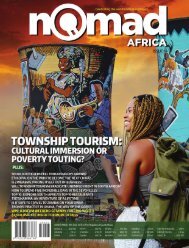Nomad_Africa_Edition12
Born from a passionate desire to dispel the negative perceptions which the world has held of the African Continent, and to replace it with a positive focus, Nomad Africa magazine celebrates life on the African continent. Covering stories from all countries and all cultures, it strives to include unique tourist attractions, business development, technology and investment opportunities as well as looking at the continent's cultural heritage. Nomad Africa inspires and breeds a conscious, knowledgeable generation of visionaries among our own, and influences positive perceptions and appreciation for the true worth of Africa worldwide.
Born from a passionate desire to dispel the negative perceptions which the world has held of the African Continent, and to replace it with a positive focus, Nomad Africa magazine celebrates life on the African continent. Covering stories from all countries and all cultures, it strives to include unique tourist attractions, business development, technology and investment opportunities as well as looking at the continent's cultural heritage. Nomad Africa inspires and breeds a conscious, knowledgeable generation of visionaries among our own, and influences positive perceptions and appreciation for the true worth of Africa worldwide.
Create successful ePaper yourself
Turn your PDF publications into a flip-book with our unique Google optimized e-Paper software.
Former Isreali Prime Minister - Levy Eshkol and Jomo<br />
Kenyatta at the state house in Nairobi, Kenya on 15 June<br />
1966.<br />
Like many other fellow Kikuyu countrymen, he refused to<br />
fight for the British. Kamau evaded the forced recruitment by<br />
moving to Narok, a town south of Nairobi, where he lived among<br />
the Maasai people, finding employment as a clerk at a local<br />
contractor.<br />
Reconciler" or "The Unifier"), which published<br />
news, articles with the purpose of<br />
unifying Kikuyu people and raising funds<br />
for the KCA.<br />
With certain concerns about the future of its<br />
East <strong>Africa</strong>n territories, the British Government<br />
began toying with the idea of forming<br />
a union of Kenya, Uganda and Tanganyika.<br />
Although this idea was fully supported by<br />
white settlers in the Central Highlands, it<br />
would be disastrous to Kikuyu interests as it<br />
was widely believed that settlers would be<br />
given self-government, while the rights of<br />
the Kikuyu would be ignored.<br />
In February 1929, Kenyatta was dispatched<br />
to London to represent the KCA in discussions<br />
with the Colonial Office, but the Secretary<br />
of State for the Colonies refused to<br />
meet him. Undeterred, Kenyatta wrote several<br />
letters to British newspapers, including<br />
The Times, raising awareness among the<br />
colonial power.<br />
Kenyatta returned to Kenya on 24 September<br />
1930 and despite failing in his mission, he<br />
had made progress in requesting for the development<br />
of independent educational institutions<br />
for Kenyans.<br />
Kenyatta returned to Britain to represent<br />
KCA’s grievances. He decided to enroll to<br />
Quaker College after his efforts were ignored<br />
by the Colonial Office. He successfully<br />
completed his studies in 1932, and in August<br />
the same year, he left for Russia to study at<br />
Moscow University after receiving an invitation<br />
from George Padmore who was a radical<br />
West Indian.<br />
However, in 1933 Kenyatta was forced to terminate<br />
his studies and return to Britain after<br />
Padmore had a disagreement with the Russians.<br />
He pursued his studies at the University<br />
College in London and in 1936, he<br />
managed to break through a police cordon<br />
to express his solidarity for Emperor Haile<br />
Selassie from Ethiopia at the London Railway<br />
station.<br />
Kenyatta published ‘Facing Mount Kenya,’<br />
using the name Jomo Kenyatta; and from<br />
then henceforth people embraced Jomo<br />
Kenyatta as his name. Later in October 1945,<br />
Kenyatta joined Kwame Nkrumah from<br />
Ghana to organise the fifth Pan <strong>Africa</strong>n congress.<br />
In 1944, the Kenya <strong>Africa</strong>n Union (KAU) came<br />
into being as the only political outlet for indigenous<br />
<strong>Africa</strong>ns in the colony. In 1947,<br />
KAU's President James Gichuru stepped<br />
down, creating an opportunity for Kenyatta<br />
to be elected as his replacement.<br />
Proving to be a popular leader and drawing<br />
large crowds wherever he travelled in<br />
Kikuyuland, Kikuyu media described him as<br />
the "Saviour", "Great Elder", and "Hero of Our<br />
Race". With great insight, Kenyatta knew that<br />
in order for independence to be achieved,<br />
KAU as a political party needed the support<br />
of all Kenyan indigenous tribes and ethnic<br />
groups. Kenyatta cleverly insisted on intertribal<br />
representation on the KAU executive,<br />
thereby ensuring that party business was<br />
70 | www.nomadafricamag.com | ...Celebrating the world’s richest continent | Issue 12





